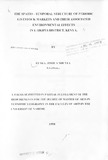| dc.contributor.author | Kyaka, Joshua M | |
| dc.date.accessioned | 2013-05-03T11:13:52Z | |
| dc.date.available | 2013-05-03T11:13:52Z | |
| dc.date.issued | 1998 | |
| dc.identifier.citation | Masters of arts in economic geography | en |
| dc.identifier.uri | http://erepository.uonbi.ac.ke:8080/xmlui/handle/123456789/18649 | |
| dc.description.abstract | Lack of access to the market and poor Spatio- Temporal integration of the marketing
space present one of the most serious drawbacks in Kenya's economic development.. The
rural market centres of this nation are fundamentally built on a periodic marketing system
and hence hold the key to Local. Regional and National articulation of exchange
processes. The development of internal trading and marketing systems is therefore
essential for a thriving market economy in Kenya in general and Laikipia district In
particular. Thus the Periodic Marketing System can not be ignored.
The objectives of this study were to
(a) Investigate .describe and analyze the Spatial and Temporal elemental components
of livestock periodic markets in Laikipia district:
(b) To determine the degree of Spatio-temporal synchronization of livestock periodic
markets in Laikipia district:
(c) To determine the factors influencing the Spatio-temporal structure of livestock
periodic marketing in Laikipia district and
(d) To examine how these livestock periodic markets contribute towards
environmental degradation/damage within the market areas.
The hypotheses tested in the study are-
(a) "The spatio-temporal structure of livestock periodic markets in Laikipia district is
not synchronized in space and time and as such proximity in space does not imply
separation in time."
(b) "There is no significant relationship between market provision and population
density, accessibility and the degree of regional specialization".
(c) "Livestock periodic markets are not responsible for any form of environmental damage/degradation within the enclosed market areas".
Geographic Information System (GIS) mapping techniques were used to present spatially
gee-referenced data and also in determining spatial correlations of market provision
densities and the market provision variables of population densitv. accessibility and degree
of regional specialization GIS overlaying technique was mainly used in this regard. Digital
photo scanning was employed in presenting various forms of environmental damage in the
enclosed market sites
The distribution of livestock periodic markets was found to be random and presenting
significant spatial disparities ;\ nearest neighbour statistic (Rn) of 10753 was computed
hence suggesting an extremely random market distribution. The temporal distribution of
marketing davs is not uniform and some divisions have more or less than their fair share of
the available marketing opportunities in the 14 day market calendar. An inverse
relationship between spatial and temporal location of livestock periodic markets was found
with an inverse correlation coefficient of -096057. which indicates that livestock periodic
markets have a high degree of spatio-ternporal svnchronization.
The market provision variables examined namely population density, accessibility and
degree of regional specialization significantly contribute towards the provision of market
opportunities. Together these three variables explain 76.77% (= 77~ 0) of the total
variation in livestock market provision in the district. Regional specialization was found to
be more strongly associated with livestock market provision than either accessibility or
population density
It was found that livestock periodic markets are responsible tor a considerable deal of
environmental damage. Excessive concentration of livestock at the market site leads to
excessive pressure In t he market enclosed area resulting to serious environmental
damage/degradation.
It is the conclusion of this study that the overall functional efficiency of livestock
marketing is depended upon a comprehensive national/local marketing policy framework
which recognizes the production realities and potentiality of the local economy,
Improvements in transport infrastructure. market information flows. and marketing
institutional structures are a pre-requisite tor successful livestock trade and marketing.
Lastly in order to make livestock marketing environmentally sustainable. a well articulated
institutional arrangement is also a pre-requisite. This will in turn depend upon the presence
of a totally comprehensive and balanced policy framework that addresses the rather
elusive and complex human-livestock - environment nexus of interactions. | en |
| dc.description.sponsorship | University of Nairobi | en |
| dc.language.iso | en | en |
| dc.title | The spatio - temporal structure of periodic livestock markets and their associated Environmental effects in laikipia district, Kenya. | en |
| dc.type | Thesis | en |

